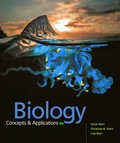
Concept explainers
Introduction:
All the organisms present in the environment is composed of a cell. The organisms are classified into two types. These are prokaryotes and eukaryotes. Prokaryotes are the organisms that do not contain a well-defined nucleus. However, eukaryotes have a well-defined nucleus properly enclosed in a nuclear membrane. A
Answer to Problem 1SA
Correct answer:
All the fungi are heterotrophs as they depend on other organisms for food. They are not capable of producing their own food. Hence, the correct answer is option c.
Explanation of Solution
Reason for correct answer:
Option c. is given as “are heterotrophs.”
The organisms that are capable of preparing their food by the process of photosynthesis are termed as autotrophs. However, the organisms that cannot prepare food and depend on other organisms are termed as heterotrophs. Fungus is also a heterotroph as it depends on other organisms for food.
Reason for incorrect answer:
Option a. is given as, “are multicelled.”
The organisms that contain one cell are called unicellular or single-celled organisms. However, the ones that are composed of more than one cell are called multicelled organisms. Fungi can be both single-celled and multicelled. The fungi with one cell are called yeasts. Hence, option a. is incorrect.
Option b. is given as, “form flagellated spores.”
Fungi have the ability to produce spores. They can produce a variety of spores such as both flagellated and non-flagellated spores. Chyratids is the only type of fungi that produce flagellated spores. However, all other types of fungi produce non-flagellated spores. Hence, option b. is incorrect.
Option d. is given as, “all of the above.”
The only correct option that holds correct for fungi is option c. This is because fungi are heterotrophic organisms as they cannot prepare their own food. However, all the other options do not explain the characteristic of fungi accurately. Hence, option d. is incorrect.
Hence, the options a., b., and d. are incorrect.
Fungi are the heterotrophic organisms as they cannot prepare food. They are dependent on other organisms for their nutrition. Thus, the correct option is c.
Want to see more full solutions like this?
Chapter 22 Solutions
EBK BIOLOGY: CONCEPTS AND APPLICATIONS
- please draw in the answers, thank youarrow_forwarda. On this first grid, assume that the DNA and RNA templates are read left to right. DNA DNA mRNA codon tRNA anticodon polypeptide _strand strand C с A T G A U G C A TRP b. Now do this AGAIN assuming that the DNA and RNA templates are read right to left. DNA DNA strand strand C mRNA codon tRNA anticodon polypeptide 0 A T G A U G с A TRParrow_forwardplease answer all question below with the following answer choice, thank you!arrow_forward
- please draw in the answeres, thank youarrow_forwardA) What is being shown here?B) What is indicated by the RED arrow?C) What is indicated by the BLUE arrow?arrow_forwardPlease identify the curve shown below. What does this curve represent? Please identify A, B, C, D, and E (the orange oval). What is occurring in these regions?arrow_forward
- Please identify the test shown here. 1) What is the test? 2) What does the test indicate? How is it performed? What is CX? 3) Why might the test be performed in a clinical setting? GEN CZ CX CPZ PTZ CACarrow_forwardDetermine how much ATP would a cell produce when using fermentation of a 50 mM glucose solution?arrow_forwardDetermine how much ATP would a cell produce when using aerobic respiration of a 7 mM glucose solution?arrow_forward
- Determine how much ATP would a cell produce when using aerobic respiration to degrade one small protein molecule into 12 molecules of malic acid, how many ATP would that cell make? Malic acid is an intermediate in the Krebs cycle. Assume there is no other carbon source and no acetyl-CoA.arrow_forwardIdentify each of the major endocrine glandsarrow_forwardCome up with a few questions and answers for umbrella species, keystone species, redunant species, and aquatic keystone speciesarrow_forward

 Biology: The Dynamic Science (MindTap Course List)BiologyISBN:9781305389892Author:Peter J. Russell, Paul E. Hertz, Beverly McMillanPublisher:Cengage Learning
Biology: The Dynamic Science (MindTap Course List)BiologyISBN:9781305389892Author:Peter J. Russell, Paul E. Hertz, Beverly McMillanPublisher:Cengage Learning Biology (MindTap Course List)BiologyISBN:9781337392938Author:Eldra Solomon, Charles Martin, Diana W. Martin, Linda R. BergPublisher:Cengage Learning
Biology (MindTap Course List)BiologyISBN:9781337392938Author:Eldra Solomon, Charles Martin, Diana W. Martin, Linda R. BergPublisher:Cengage Learning Concepts of BiologyBiologyISBN:9781938168116Author:Samantha Fowler, Rebecca Roush, James WisePublisher:OpenStax College
Concepts of BiologyBiologyISBN:9781938168116Author:Samantha Fowler, Rebecca Roush, James WisePublisher:OpenStax College Biology Today and Tomorrow without Physiology (Mi...BiologyISBN:9781305117396Author:Cecie Starr, Christine Evers, Lisa StarrPublisher:Cengage Learning
Biology Today and Tomorrow without Physiology (Mi...BiologyISBN:9781305117396Author:Cecie Starr, Christine Evers, Lisa StarrPublisher:Cengage Learning Biology: The Unity and Diversity of Life (MindTap...BiologyISBN:9781305073951Author:Cecie Starr, Ralph Taggart, Christine Evers, Lisa StarrPublisher:Cengage Learning
Biology: The Unity and Diversity of Life (MindTap...BiologyISBN:9781305073951Author:Cecie Starr, Ralph Taggart, Christine Evers, Lisa StarrPublisher:Cengage Learning





